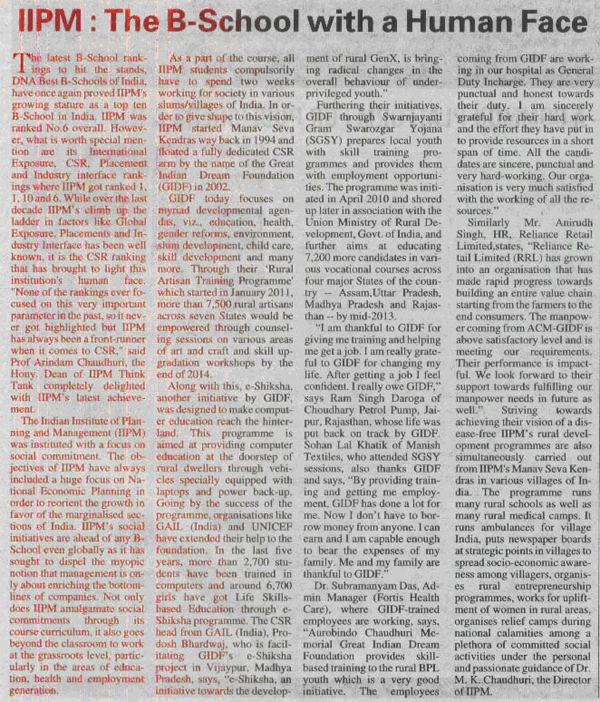Siddharth Varadarajan, Editor, The Hindu, wrote a clarification this morning with reference to an ad released by IIPM in major newspapers across the country earlier this week. The Hindu did not carry the advertisement.
The clarification is headlined “IIPM’s claim on The Hindu: A clarification”.
Here’s the complete clarification by Varadarajan.
“A write-up titled “IIPM: The B-School with a Human Face,” was published in the Delhi edition of The Hindu on September 2, 2012 as part of what was clearly marked as an “Advertisers’ Feature” on the Delhi Book Fair. The material was supplied to our Advertisement Department by representatives of the Indian Institute of Planning and Management (IIPM). It was published with the clear understanding on the part of all concerned that it was paid-for advertisement material and not editorial matter.
Given these facts and circumstances, it was illegal and unethical for IIPM to include a line in an advertisement it recently placed in certain newspapers that “IIPM has been called the B-School with a ‘Human Face’ by The Hindu,” implying an endorsement of its credentials by this newspaper. The Hindu was in fact approached by IIPM’s representatives last week seeking to publish the same advertisement, but we insisted that the inaccurate claim about The Hindu having described it as a “B-School with a human face” be deleted from it. IIPM refused to do this and went ahead and placed the advertisement in several newspapers.
The Hindu hereby would like to make it clear to current and prospective students of IIPM that it has not made any such editorial endorsement of the institution. We have now formally written to IIPM asking it to refrain from repeating the claim, and putting it on notice of our intent to proceed suitably against it if it persists in doing so.”
This is a tricky one. First, let’s take a look at the ‘write-up’. This is how the write-up appeared in The Hindu (image courtesy IIPM’s Facebook page)
Impact Shorts
More Shorts[caption id=“attachment_669680” align=“alignleft” width=“600”] This is how the write-up appeared in The Hindu[/caption]
The ‘write-up’, whatever the understanding between _The Hindu’_s ad sales teams and IIPM’s representatives, is seen by IIPM’s marketing team as bona fide editorial, which is what Varadarajan objects to. The same write-up, if it had appeared in the main paper, would certainly have had the word ‘advertorial’ (or an equivalent) appearing alongside the text.
When the word advertorial or an equivalent does not appear alongside the content, is it editorial or paid for advertising?
This is an issue that Justice Katju and the Press Council will find difficult to resolve. Varadarajan is perfectly accurate when he says that the pages in which the ‘write-up’ appeared were in a supplement clearly marked ‘Advertisers’ Feature’. By definition, according to Varadarajan’s argument, all content in the feature is paid for, so all content is advertising - therefore, IIPM cannot make the claim that the ‘write-up’ is The Hindu’s editorial content.
This is where it gets tricky. Supplements, advertisers features, marketing initiative, promotion are many of the terms used by ad sales teams when there is a section that sees both ads and paid for ’editorial’. It is common practice in newspapers and magazines across the country for sales teams to offer a ‘combined deal’ - an ad of a defined size and a ‘write-up’ to an agreed length. The editorial teams, in almost all cases, have nothing whatsoever to do with these pages, with the ad sales teams either having their own sources to write the articles or to engage the services of freelance writers.
Much will depend, in the current instance, on what IIPM’s release order says. If the deal between IIPM and The Hindu was an ad+write up combination, it is unlikely that the release order will mention the write up. The billing will be for the ad alone. The write up would be a part of the exchange of communication between client and publication before the finalisation of the deal.
The Free Press Journal carried the same ‘write-up’ as The Hindu, with the same flattering headline - except that they labeled it as editorial, even to the extent that the article is credited to the FPJ Bureau , suggesting that the write-up was paid for.
The Hindu seems to have carried the ‘write-up’ as an article as well. IIPM posted the link on September 3, 2012, the morning the communication appeared, on their Facebook page. The link now leads to a message saying “The article you are looking for is no longer available in this website."
That makes it more interesting. The offending communication did, at some point, exist on The Hindu’s website - and was labeled an article by them, not as an advertisement.
Varadarajan’s clarification opens up a Pandora’s Box and a new debate for media watchers to mull over. Is a paid for write up called a write-up or article or would it, as Varadarajan seems to believe, be called an advertisement?
If it looks like an ad, I’d call it an ad’ if it looks like editorial, I’d call it paid editorial.
In the current instance, I’d call it paid editorial.


)

)
)
)
)
)
)
)
)



